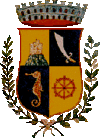Maiori
| Maiori | ||
|---|---|---|
| Comune | ||
| Comune di Maiori | ||
 | ||
| ||
 | ||
 Maiori | ||
| Coordinates: 40°39′N 14°39′E / 40.650°N 14.650°ECoordinates: 40°39′N 14°39′E / 40.650°N 14.650°E | ||
| Country | Italy | |
| Region | Campania | |
| Province | Salerno (SA) | |
| Frazioni | Erchie, Ponteprimario, San Pietro, Santa Maria delle Grazie, Vecite | |
| Government | ||
| • Mayor | Antonio Della Pietra | |
| Area | ||
| • Total | 16 km2 (6 sq mi) | |
| Elevation | 5 m (16 ft) | |
| Population (31 December 2004) | ||
| • Total | 5,685 | |
| • Density | 360/km2 (920/sq mi) | |
| Demonym | Maioresi | |
| Time zone | CET (UTC+1) | |
| • Summer (DST) | CEST (UTC+2) | |
| Postal code | 84010 | |
| Dialing code | 089 | |
| Patron saint | Santa Maria a Mare | |
| Saint day | 15 August | |
| Website | Official website | |
Maiori (Neapolitan, Majure; originally Reghinna Maior) is a town and comune on the Amalfi coast in the province of Salerno (Campania, Italy). It has been a popular tourist resort since Roman times, with the longest unbroken stretch of beach on the Amalfi coastline.
History
The origins of the town are unclear but the original name of the town was Reghinna Maior, in contrast to the neighbouring town, Minori, Reghinna Minor. All places along the coast were formed by alternating conquerors - such as the Etruscans or the Romans.

Between 830 and 840, the places of the coast united to form a confederation of Amalfi States. In this Amalfi Sea Republic, the places between Lettere and Tramonti and between Cetara and Positano, along with the island of Capri, were united; and their inhabitants were all called Amalfitaner. At that time, each city retained its own name and administrative autonomy, but had a specific role in this federation.[1]
Later it became part of the Principality of Salerno, and then of the Kingdom of Naples, of which it followed the history until the 19th century.
Main sights
- Collegiate Church of Santa Maria a Mare. The colourful maiolica tiled dome looks like Maiori's crown, whose jewels are treasured inside the Sacred Art Museum just next to the Church.[2]
- Santa Maria de Olearia in Maiori. The ruins of the XI Benedictine Abbey just above Maiori, is a great way to enjoy the most ancient part of town.[3]
- Falerzio Mount and Avvocata Church. The highest peak of the Amalfi Coast and the Sanctuary on the plain above Mount Mirteto.[4]
Transport
- Airport
![]() The nearest airport is Salerno-Pontecagnano Airport (QSR).
The nearest airport is Salerno-Pontecagnano Airport (QSR).
In film
In the mid-20th century, Roberto Rossellini filmed some of his films here: Paisà (1946); "Il Miracolo" ("The Miracle"), the second episode of the movie L'Amore (Ways of Love, 1948); La macchina ammazzacattivi (Machine to Kill Bad People, 1952); and Il viaggio in Italia (Journey to Italy, 1953). A film festival is held every November at which the Premio Internazionale Roberto Rossellini is awarded.[5]
Notes and references
- ↑ "History of Maiori". Retrieved 2006-04-30.
- ↑ "Collegiate Church Santa Maria a Mare". Retrieved 26 April 2012.
- ↑ "Santa Maria de Olearia in Maiori". Retrieved 26 April 2012.
- ↑ "Falerzio Mount and Avvocata Church". Retrieved 26 April 2012.
- ↑ "Rossellini Award". Retrieved 2008-03-05.
See also
- Erchie (Maiori)
- Amalfi Coast
- Sorrentine Peninsula
External links
![]() Media related to Maiori at Wikimedia Commons
Media related to Maiori at Wikimedia Commons
- Maiori Pro Loco Official Tourism website
- Maiori Tourism website
- (Italian) Churches of Maiori
- News and videos from Maiori Italy
- Maiori Amalficoast Web Site
- Erchie di Maiori Amalficoast Web Site
- Maiori Webcam
- Practical Guide Maiori

| |||||||||||||||
